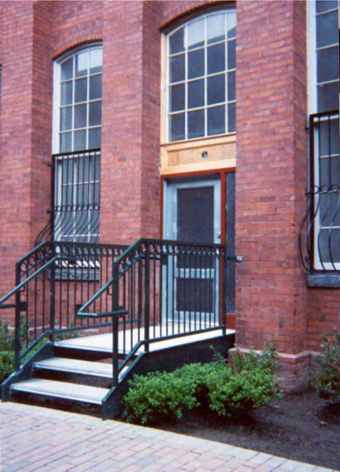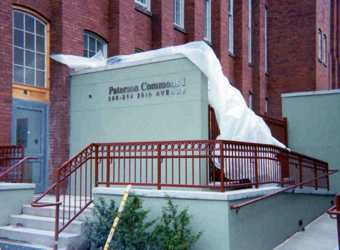Back
Paterson Commons: Former Boris Kroll Site
Paterson City, Passaic County
The formerly abandoned Boris Kroll Mill
in Paterson has been transformed into market-rate rental
housing that is hoped to spark urban revitalization. The
first phase of redevelopment has created 39 new apartments
and 10,000 square feet of retail and office space. These
spaces are ready for use and are currently accepting tenant
applications. The city block at 20th Avenue and State Street
in the “People’s Park” area of Paterson
once housed a looming plant which employed many area residents.
However, when the owner of the plant declared bankruptcy
and ceased plant operation, the site lay vacant for over
a decade, becoming an eyesore for the community.
With financial support and enthusiasm from the city and
private developers along with state assistance, the area
has been given new life. The buildings, which are listed
on the National Register
of Historic Places, have retained their beautiful nineteenth
century architecture with brick fronts, high ceilings, and
grid windows. This redevelopment represents the largest
upsurge of new, market-rate housing in Paterson in over
twenty years. However, this only the beginning: work has
begun on transforming another Boris Kroll building into
a new elementary school. Further redevelopment will also
provide 150 more rental units and 50,000 square feet of
retail and office space.
The plant’s closing triggered the Industrial
Site Recovery Act (ISRA), which requires that an environmental
assessment be conducted. However, there was no viable responsible
party to conduct such an assessment because the owner had declared
bankruptcy.
Site investigation overseen by case
manager Joseph Goliszewski revealed two areas of environmental
concern: a fuel tank under the sidewalk and pesticide
contamination in the northwest building. The fuel
tank was left in place with a deed notice and an engineering
control to prevent exposure. The road and sidewalk
serve as the "cap", a.k.a. engineering control.
The pesticide contamination, the source
of which remains unknown, proved more difficult to remedy,
as it extended eighteen feet beneath the ground, into the
underlying water table. A two-phase deed notice was issued
including both an institutional and an engineering control.
The site was capped, and at the advice of Technical Coordinator,
Chris Lacy, a venting system was installed to protect against
any indoor air intrusion. A No Further Action/Covenant Not
to Sue letter was issued November 10, 2003 by current case
manager, Karen Lesto, who inspected and certified the engineering
control. The surrounding groundwater became part of a classification
exception area, as the class IIA standards for potable water
are not met. Residents are on a municipal water supply.
In April 2000, the site became the first
recipient of a Downtown Living Initiative Program Award,
which seeks to help cities attract and retain middle-income
households, and allow people to rediscover the excitement
and convenience of city life. The $1.5 million low-interest
loan provided by the Department
of Community Affairs (DCA), along with a $600,000 contribution
from the City of Paterson, funded the conversion of the
historic mill into a complex of apartments, stores and offices
now known as Paterson Commons. The project is particularly
welcome in the city, and local residents and officials believe
it illustrates their faith in renewal and the future. Total
project costs were estimated to be $3.66 million by the
developers Alpert & Alpert. The developer also utilized
the Rehabilitation Tax Credit Program for certified historic
structures undergoing certified rehabilitation, overseen
by the New Jersey Historic
Preservation Office. Vice President Joseph Alpert believes
that "it was the state's involvement in the project
that helped convince the private sector this was a sound
investment."1
1"Market-Rate Rentals Coming
to Paterson, Bayonne." New Jersey Department of Community
Affairs Press Release: April 6, 2000. |
 The site after the transformation. The site after the transformation.

The site during the transformation.
|
 The site after the transformation.
The site after the transformation.